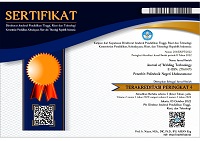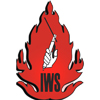The effect of weld groove variations on the toughness of welding joints of AISI 1050 material
Abstract
SMAW (Shielded Metal Arc Welding) welding is a metal joining process that uses heat energy to melt the workpiece and electrode (fill material). The flux material used for type E7016, a low hydrogen electrode wire typically used for welding heavy-duty plates and structures. Its use is for welding medium carbon steel, bridges, ships and machinery. The result of welding electrode E7016 is very smooth, deep penetration, crack resistant, ductile, good weld appearance and stable arc, the material used in the SMAW welding process is AISI 1050 steel. While AISI 1050 steel is steel that has a carbon content of 0.50 % so that it is classified as medium carbon steel. This steel is widely used in the market because it has many advantages, one of which is as an automotive component. This steel has the characteristics of good machinability, good wear resistance and medium mechanical properties. This study aims to determine the shock strength (impact) and the difference in the time of making weld grooves on SMAW welding results on AISI 1050 steel with variations of Double Bevel and Double V Groove grooves. In testing in the Weld Metal area with a current used of 110 Ampere. From the tests that have been carried out, it is known that the value of the highest impact strength is in the Double Bevel groove which has a value of 1.91 Joule/mm2, for the manufacture of welded grooves where the Double Bevel time is shorter than Double V Groove, so the time produced by Double Bevel which is 3.44 minutes/second.
Keywords
Full Text:
PDFReferences
A. Tamlicha, I. Hasanuddin, Y. Muchlis, A. Z. Mubarak, T. M. Yusuf, and A. Amri, “Numerical Analysis of Traditional Aceh Fishing Boat with Various Scenario Loading and Hull Thickness, Manufacturing by Metal Plasma Cutting and Welding,” in Proceedings of the 2nd International Conference on Experimental and Computational Mechanics in Engineering, 2021, pp. 301–318.
S. Widharto, “Welding Inspection,” Jakarta: Mitra Wacana Media, vol. 7, 2013.
L. P. Ketaren, U. Budiarto, and A. W. B. Santosa, “Analisa Pengaruh Variasi Kampuh Las dan Arus Listrik Terhadap Kekuatan Tarik Dan Struktur Mikro Sambungan Las GMAW (Gas Metal ARC Welding) Pada Aluminium 6061,” J. Tek. Perkapalan, vol. 7, no. 4, 2019.
A. Farhan and T. A. Fadhilah, “Impact toughness of ASTM A36 low carbon steel by metal active gas (MAG) welding process using different cooling media,” Metalurgija, vol. 61, no. 3–4, pp. 641–644, 2022.
A. Ginting, A. Hamsi, and H. Sibarani, “Pengaruh Variasi Sudut Kampuh V Tunggal dan Kuat Arus pada Sambungan Logam Aluminium–Mg 5083 terhadap Kekuatan Tarik Hasil Pengelasan TIG,” 2008.
M. Siddiq, N. Nurdin, and I. Amalia, “Pengaruh jenis kampuh terhadap ketangguhan sambungan pengelasan material St37 dengan AISI 1050 menggunakan proses SMAW,” J. Weld. Technol., vol. 1, no. 1, pp. 11–16, Jun. 2019.
I. Arif Rahman Hakim, “Analisa pengaruh variasi kampuh terhadap hasil pengelasan SMAW pada stainless steel 304 menggunakan pengujian ultrasonic dan kekuatan tarik.,” J. POLIMESIN, vol. 18, no. 1, pp. 30–38, 2020, doi: http://dx.doi.org/10.30811/jpl.v18i1.1057.
V. A. Setyowati and S. Suheni, “VARIASI ARUS DAN SUDUT PENGELASAN PADA MATERIAL AUSTENITIC STAINLESS STEEL 304 TERHADAP KEKUATAN TARIK DAN STRUKTURMAKRO,” J. IPTEK, vol. 20, no. 2, p. 29, Dec. 2016, doi: 10.31284/j.iptek.2016.v20i2.40.
S. A.Jalil, Z. Zulkifli, and T. Rahayu, “ANALISA KEKUATAN IMPAK PADA PENYAMBUNGAN PENGELASAN SMAW MATERIAL ASSAB 705 DENGAN VARIASI ARUS PENGELASAN,” J. POLIMESIN, vol. 15, no. 2, p. 58, Sep. 2017, doi: 10.30811/jpl.v15i2.376.
A. Azwinur, M. Yudi, and Z. Zulkifli, “Pengaruh media pendingin terhadap kekerasan dan ketangguhan hasil pengelasan material AISI 1050 pada proses las MAG,” J. POLIMESIN, vol. 18, no. 2, pp. 124–130, 2020.
A. Azwinur and M. Muhazir, “Pengaruh jenis elektroda pengelasan SMAW terhadap sifat mekanik material SS400,” J. POLIMESIN, vol. 17, no. 1, pp. 19–25, Feb. 2019, doi: 10.30811/JPL.V17I1.870
DOI: http://dx.doi.org/10.30811/jowt.v4i1.2998
Refbacks
- There are currently no refbacks.

This work is licensed under a Creative Commons Attribution-ShareAlike 4.0 International License.
Ciptaan disebarluaskan di bawah Lisensi Creative Commons Atribusi-BerbagiSerupa 4.0 Internasional.
Mailing Address:
Politeknik Negeri Lhokseumawe
Jl. Banda Aceh-Medan
Km. 280,3, Buketrata, Mesjid Punteut, Blang Mangat,
Kota Lhokseumawe, 24301
Propinsi Aceh,
Indonesia























